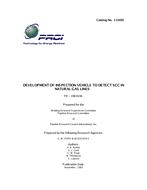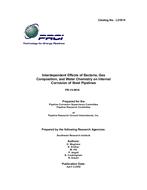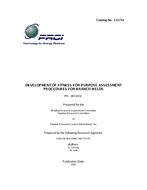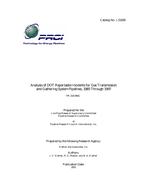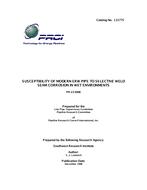PRCI PR-198-9108
- Development of Inspection Vehicle to Detect SCC in Natural Gas Lines
- Report / Survey by Pipeline Research Council International, 11/01/1993
- Publisher: PRCI
$198.00$395.00
C.W. Pope & Associates
Need: Stress corrosion cracking (SCC) poses a serious threat to aging underground cathodically protected gas pipelines. As coatings deteriorate, conditions suitable for corrosion and SCC become more common. There have been many ruptures throughout the world attributed to SCC. One of the most important steps in combating failure by SCC is regular, reliable and cost effective monitoring of pipelines. Current methods available (including hydrotesting and magnetic particle testing) are either expensive, time consuming, or not entirely reliable. Regular testing of pipelines and the detailed study of the results will improve the understanding of SCC initiation and propagation.
Benefit: C. W. Pope and Associates Pty. Ltd. (CWP), an Australian based NDT company, developed a manual ultrasonic scanning system for detecting SCC in pipelines. This system was used to inspect the lower circumferential section of unpressurized lengths of the 34" Moomba to Sydney gas transmission pipeline operated by The Pipeline Authority (TPA). The manual system successfully located SCC colonies. CWP, in association with The University of Newcastle, then developed a microprocessor controlled system based on piezoelectric wheel probe technology. This system was trialled in Peterborough, South Australia in May 1990. Following the awarding of this research project (PR-198-9108). CWP incorporated the development work into their core business with the creation of the Product Development Section. This section was entirely committed to the development of the system and the PRC project. The redesign of the system included EMAT technology. Although not new, EMATs had not previously been made available to the gas industry in the detection of SCC. This project involved in excess of 13500 development man hours over a 22 month period. This report describes the development of the system and the Newcastle field trials, the Australian field trials and the USA field trials concluding in September 1992. The report also addresses the suitability of each technology in detecting SCC in buried
natural gas pipeline and makes design recommendations for the future. Future developments in the system are planned in the areas of enhancing the reliable detection of SCC, imaging of SCC and enhanced calibration capabilities.
Result: EMAT technology developed through the project has proved to be superior to piezoelectric technology in the detection of intergranular stress corrosion cracking in the lower section of depressurised buried natural gas pipelines. The two technologies, however, can give similar results in ideal laboratory conditions. EMAT technology is more independent of natural interferences found in field conditions. The EMAT technology is capable of faster sampling speeds, does not require external liquid couplant and is less susceptible to false detections. The EMAT technology is presently of small dimension, low power, battery operated and is of very robust design.
Related Products
PRCI PR-15-9916
Interdependent Effects of Bacteria, Gas Composition, and Water Chemistry on Internal Corrosion of St..
$348.00 $695.00
PRCI PR-185-9332
Development of Fitness-for-Purpose Assessment Procedures for Branch Welds..
$25.00 $49.00
PRCI PR-218-9801
Analysis of DOT Reportable Incidents For Gas Transmission and Gathering System Pipelines, 1985-1997..
$268.00 $535.00
PRCI PR-15-9306
Susceptibility of Modern ERW Pipe to Selective Weld Seam Corrosion in Wet Environments..
$48.00 $95.00

